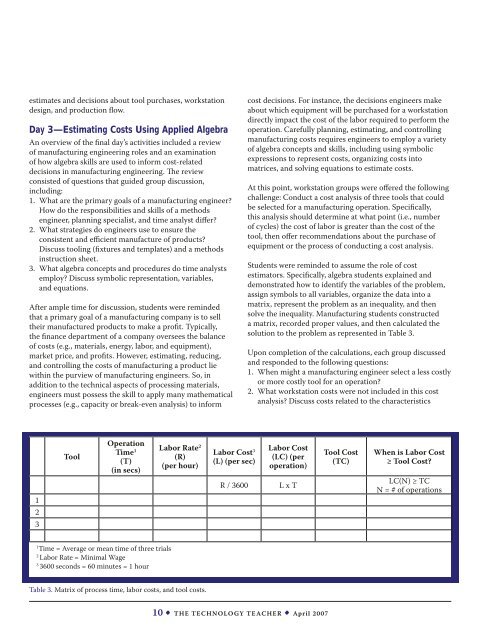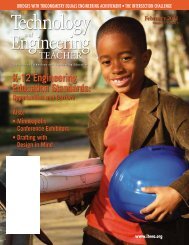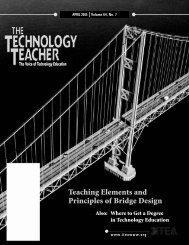Vol 66, No. 7 - International Technology and Engineering Educators ...
Vol 66, No. 7 - International Technology and Engineering Educators ...
Vol 66, No. 7 - International Technology and Engineering Educators ...
Create successful ePaper yourself
Turn your PDF publications into a flip-book with our unique Google optimized e-Paper software.
estimates <strong>and</strong> decisions about tool purchases, workstation<br />
design, <strong>and</strong> production flow.<br />
D ay 3—Estimating Costs U sing A pplied A lgebra<br />
An overview of the final day’s activities included a review<br />
of manufacturing engineering roles <strong>and</strong> an examination<br />
of how algebra skills are used to inform cost-related<br />
decisions in manufacturing engineering. The review<br />
consisted of questions that guided group discussion,<br />
including:<br />
1. What are the primary goals of a manufacturing engineer?<br />
How do the responsibilities <strong>and</strong> skills of a methods<br />
engineer, planning specialist, <strong>and</strong> time analyst differ?<br />
2. What strategies do engineers use to ensure the<br />
consistent <strong>and</strong> efficient manufacture of products?<br />
Discuss tooling (fixtures <strong>and</strong> templates) <strong>and</strong> a methods<br />
instruction sheet.<br />
3. What algebra concepts <strong>and</strong> procedures do time analysts<br />
employ? Discuss symbolic representation, variables,<br />
<strong>and</strong> equations.<br />
After ample time for discussion, students were reminded<br />
that a primary goal of a manufacturing company is to sell<br />
their manufactured products to make a profit. Typically,<br />
the finance department of a company oversees the balance<br />
of costs (e.g., materials, energy, labor, <strong>and</strong> equipment),<br />
market price, <strong>and</strong> profits. However, estimating, reducing,<br />
<strong>and</strong> controlling the costs of manufacturing a product lie<br />
within the purview of manufacturing engineers. So, in<br />
addition to the technical aspects of processing materials,<br />
engineers must possess the skill to apply many mathematical<br />
processes (e.g., capacity or break-even analysis) to inform<br />
cost decisions. For instance, the decisions engineers make<br />
about which equipment will be purchased for a workstation<br />
directly impact the cost of the labor required to perform the<br />
operation. Carefully planning, estimating, <strong>and</strong> controlling<br />
manufacturing costs requires engineers to employ a variety<br />
of algebra concepts <strong>and</strong> skills, including using symbolic<br />
expressions to represent costs, organizing costs into<br />
matrices, <strong>and</strong> solving equations to estimate costs.<br />
At this point, workstation groups were offered the following<br />
challenge: Conduct a cost analysis of three tools that could<br />
be selected for a manufacturing operation. Specifically,<br />
this analysis should determine at what point (i.e., number<br />
of cycles) the cost of labor is greater than the cost of the<br />
tool, then offer recommendations about the purchase of<br />
equipment or the process of conducting a cost analysis.<br />
Students were reminded to assume the role of cost<br />
estimators. Specifically, algebra students explained <strong>and</strong><br />
demonstrated how to identify the variables of the problem,<br />
assign symbols to all variables, organize the data into a<br />
matrix, represent the problem as an inequality, <strong>and</strong> then<br />
solve the inequality. Manufacturing students constructed<br />
a matrix, recorded proper values, <strong>and</strong> then calculated the<br />
solution to the problem as represented in Table 3.<br />
Upon completion of the calculations, each group discussed<br />
<strong>and</strong> responded to the following questions:<br />
1. When might a manufacturing engineer select a less costly<br />
or more costly tool for an operation?<br />
2. What workstation costs were not included in this cost<br />
analysis? Discuss costs related to the characteristics<br />
Tool<br />
Operation<br />
Time 1<br />
(T)<br />
(in secs)<br />
Labor Rate 2<br />
(R)<br />
(per hour)<br />
Labor Cost 3<br />
(L) (per sec)<br />
Labor Cost<br />
(LC) (per<br />
operation)<br />
Tool Cost<br />
(TC)<br />
When is Labor Cost<br />
≥ Tool Cost?<br />
1<br />
2<br />
3<br />
R / 3600<br />
L x T<br />
LC(N) ≥ TC<br />
N = # of operations<br />
1<br />
Time = Average or mean time of three trials<br />
2<br />
Labor Rate = Minimal Wage<br />
3<br />
3600 seconds = 60 minutes = 1 hour<br />
Table 3. Matrix of process time, labor costs, <strong>and</strong> tool costs.<br />
10 • The <strong>Technology</strong> Teacher • April 2007
















